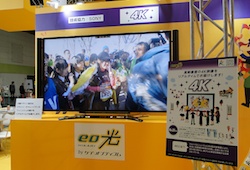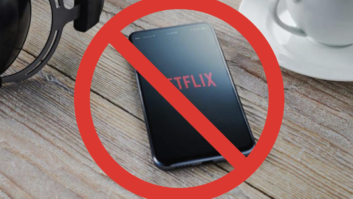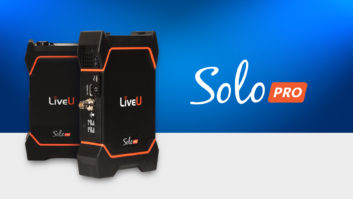
Late last month Japanese telco K-Opticom used high-efficiency video coding (HEVC) to stream the eight hour Osaka Marathon in 4K, laying claim to be a world first 4K transmission in realtime.
Elemental Technologies, which says it is the only video processing vendor offering realtime 4K/HEVC encoding, explained to TVBEurope how it was done.
“Prior to the realtime 4K/HEVC transmission of the Osaka 2013 Marathon, live 4K encoding in the new HEVC standard had been regarded as a very tough challenge given its complexity,” said Keith Wymbs, VP of marketing for Elemental.
“Elemental definitely proved that realtime 4K/HEVC is now a technical reality and this is a testament to the combined power and flexibility of our video processing solutions.”
Two Sony PMW-F55 CineAlta 4K cameras were used to acquire content at the midpoint and finish line of the race.
K-Opticom (K-OPT) used Elemental Live systems to provide HEVC encoding of 4K/59.94p material acquired from the cameras. Each camera sent source content to Elemental systems via live 3G-SDI interfaces.
The content was encoded in HEVC by Elemental software in realtime at 4K (at 30p) and streamed over K-OPT optical fibre to a PC-based decoder with final rendering on an 84-inch Sony 4K Bravia TV located in a special K-OPT exhibit at the Intex (International Exhibition Center) near the finish line.
According to Wymbs, the test held challenges. These related to the broader 4K/HEVC ecosystem, challenges associated with availability of 4K/HEVC-ready technology solutions, and those associated with the weather.
“4K Ultra HD video presents a challenge in terms of the bandwidth required to deliver a smooth and immersive viewing experience,” he explained.
“We’re in very early days with 4K, and there are still gaps that exist in the overall 4K/HEVC ecosystem. For example, the standards for physically conveying 4K at 60fps signals from one device to another have not been finalised.” It also had to overcome the limited availability of 4K/HEVC-ready decoders.
“K-OPT did a terrific job of overcoming these challenges to create a cohesive workflow that delivered a great result,” he added. “Elemental bridged a major gap in the ecosystem with its ability to reliably deliver 4K content in realtime at high quality. We identified a suitable 4K/HEVC-ready PC-based decoder to support the realtime transmission. The key encoding challenge is the computational complexity of HEVC compression (up to 10x the processing power) and the pixel intensity of the 4K resolution (at 4x 1080p). Both of these dimensions, when combined, pose an encoding challenge that no one in the industry has solved in realtime until this event.
“Finally, on the weather front, the big challenge was maintaining focus with the imminent threat of two typhoons headed directly toward Osaka. Fortunately, the sun shone brightly on race day.”
Wymbs believes that a key lesson from the test is that the evolution to HEVC could happen faster than most codec transitions in the past. While the transition will take a decade or more to reach critical mass, the transition could occur with a steep ramp in the next few years.
“Given that this event shows the promise not only of 4K but also of higher resolution video, it provides some level of comfort to know that there are some technology providers with not only future-proof offerings, but ones that are future-proven,” he said. “It eliminates some of the migration risk that typically exists in fundamental technology shifts.”
He dubbed the test “a huge and significant step forward” for the industry with the potential to usher in new revenue opportunities, “including 4K, a whole new level of world-class sports and other live event coverage, and more passion and immediacy than ever for fans and viewers.”
The timing is critical given next year’s World Cup and Winter Olympics events. Elemental is already teed up to participate in multiple 4K/HEVC trials through the end of 2013 and in the first part of 2014. It cannot disclose customer names, but confirmed its involvement “with major content programmers and distributors from around the world.”
Next-generation HEVC set-top boxes will play a crucial role in content programmers’ and distributors’ Ultra HD (4K and beyond) rollouts. IHS Electronics & Media (IHS E&M) issued research in October 2013 that forecast 140 million TV households with at least one Ultra HD TV and more than 50 million Ultra HD set-top boxes installed by 2020. Translation: HEVC enabled.
This year saw several market trends and technology advances that will lay the ground work for initial next-generation, HEVC-enabled set-top box availability:
Increased OTT and online video services;
Decreasing 4K TV prices and increased availability of 4K content (2014 Winter Olympics) and services (Netflix 4K service in 2014);
Ultra HD and HEVC video decoding set-top-box chip introductions from manufacturers such as Broadcom, Sigma Designs, STMicroelectronics, ViXS and Zenverge;
Trials involving special HEVC-enabled decoders from Fraunhofer, NTT DoCoMo, Tata Elxsi among others.
Wymbs believes that Elemental will play a vital role as pay TV operators and broadcasters transition their MPEG-2 and H.264 infrastructures to HEVC/H.265 to accommodate more high definition OTT services and UltraHD channels. “We are already ahead of the game with support for 4K HEVC, having implemented the new compression codec within its core video engine,” he said.
By Adrian Pennington







